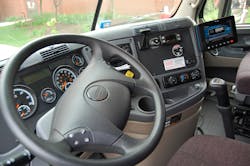How to benefit from ELDs
By Frank Schneider, CalAmp
With 15 years of experience in the sensor and software-as-a-service (SaaS) market, Frank Schneider, director of product management for CalAmp, believes electronic logging devices (ELDs) are “just the starting point” to harnessing the full business potential of the connected truck. In this guest column, he explains how such “connectivity” can benefit commercial vehicle operators.
ELDs entered the U.S. trucking industry on December 18, 2017, followed by a three-month “soft enforcement” period (which ends April 1) designed to help motor carriers, drivers, and inspectors adjust to this new way of doing business.
Although change is never easy, change often generates new opportunities and, frankly, the trucking industry is in need of a disruption.
It is facing some big challenges, such as driver shortages and aging infrastructure. The introduction of ELDs is just the start for the connected truck has the potential to bring a wealth of opportunity to the industry. Trucks as we know them are changing.
Other industries have weathered the influx of technology. For example, the taxi industry is adapting to its on-demand competitors by installing digital payment options and offering better service. There is even talk about changing the medallion system in some large cities, which is a huge deal.
Then there is the hospitality industry, which is embracing technology with check-ins by tablet kiosk or customer phone, which also may serve as a room key.
In short, the connected world is creating new ways to do business.
ELDs are the first step for some into the connected truck realm and the transition from paper to digital doesn’t need to be difficult.
Here are some ELD implementation guidelines to make your transition to digital hours of service (HOS) logging easier:
- Determine the best ELD solution for your fleet – what type of configuration works best for your operations. It can be a vehicle-installed device (telematics module with an ELD-dedicated tablet) or your own device, such as a smartphone;
- Review the Federal Motor Carrier Safety Administration (FMCSA) ELD checklist to select a provider – there are sixteen features or functions to consider when choosing a solution;
- Install and test your solution – allow for enough time for a test period after the installation to work out any systems integration issues;
- Train your drivers and operations personnel – walk the team through what to do during a roadside inspection, how to access reports, the process for handling edits, etc.;
- Update policies and procedures as needed – adjust any procedures, manuals, training material and day-to-day processes to reflect the handling of digital logbooks.
How will technology transform trucking and introduce opportunity, not just mandates? Fleets and drivers alike can benefit from ELDs, and there are ripple effects into the supply chains they support:
- Route scheduling – Data helps fine tune the best routes based on real-time, objective information;
- Shipper and receiver communication – Driver time is valuable so better communication squeezes out current inefficiencies, such as making receiving gate to dock times faster and improving lot organization for quicker trailer pickups/drop-offs;
- Supply chain contracts – Shippers typically seek the lowest cost operator to transport goods, yet the emerging market will dictate new terms, such as adding penalties for starting a driver on the clock and then dropping them or allowing carriers and drivers to select customers who don’t waste their time.
Once you have implemented a telematics ELD program, more opportunities and ways for you to stay competitive will become visible.
Now is the time to tap into the power of your truck.
